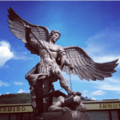Madrid, Cundinamarca
| Madrid | ||
|---|---|---|
| Municipality and town | ||
|
Church of Madrid | ||
| ||
 Location of the municipality and town of Madrid in the Cundinamarca Department of Colombia | ||
 Madrid Location in Colombia | ||
| Coordinates: 4°44′04″N 74°16′06″W / 4.73444°N 74.26833°W | ||
| Country |
| |
| Department |
| |
| Province | Western Savanna Province | |
| Founded | 7 June 1559 | |
| Founded by | Pedro Fernández Madrid | |
| Government | ||
| • Mayor |
Orlando Alberto Cardona Rojas (2016-2019) | |
| Area | ||
| • Municipality and town | 120.5 km2 (46.5 sq mi) | |
| • Urban | 7.5 km2 (2.9 sq mi) | |
| Elevation | 2,554 m (8,379 ft) | |
| Population (2015) | ||
| • Municipality and town | 77,627 | |
| • Density | 640/km2 (1,700/sq mi) | |
| • Urban | 67,527 | |
| Demonym(s) | Madrileño | |
| Time zone | Colombia Standard Time (UTC-5) | |
| Area code(s) | +1 | |
| Website | Official website | |
Madrid (Spanish pronunciation: [maˈðɾið]) is a town and municipality in the Western Savanna Province, part of the department of Cundinamarca, Colombia. The city is located at 21 kilometres (13 mi) from the capital Bogotá. The city's main and biggest industry is the growing of flowers, especially roses which are mostly exported to the United States and Japan. Madrid borders Bojacá, El Rosal, Facatativá, Funza, Mosquera, Sibaté, Soacha, Subachoque, Tabio and Tenjo.[1]
Etymology
Madrid is named after its founder; Pedro Fernández Madrid.
History
The area of Madrid was inhabited early in the history of inhabitation of the Bogotá savanna, evidenced by archaeological findings at Lake Herrera. The Muisca inhabited the area before the Spanish conquest and had rich agricultural lands established in the region.
Modern Madrid was founded on June 7, 1559.[1]
Madrid is well known because it harbors the Academy of Subofficers (non-commissioned officers) of the Colombian Air Force. The main highway to Medellín (also known as "variante") bisects the city and leads to the northern part of Colombia from Bogotá.[1]
Economy
Madrid has some other industries as manufacturing, retail stores and food processing.Some new business developments such as the Celta trade park are undergoing constructions. Such places are intended to be used as a reception point to the arrival of imported goods that will be later allowed to enter Bogota. Nearby towns such as Funza and Mosquera are related to this particular project.[1]
Gallery
- Statue in Madrid
 Statue in Madrid
Statue in Madrid Train station
Train station
References
- 1 2 3 4 (Spanish) Official website Madrid
| Wikimedia Commons has media related to Madrid, Cundinamarca. |
Coordinates: 4°44′04″N 74°16′06″W / 4.73444°N 74.26833°W
.svg.png)